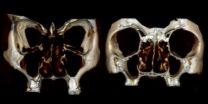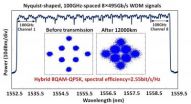Havoc in biology's most-used human cell line
Genome of HeLa cells sequenced for the first time
2013-03-12
(Press-News.org) HeLa cells are the world's most commonly used human cell lines, and have served as a standard for understanding many fundamental biological processes. In a study published today in G3: Genes, Genomes and Genetics online, scientists at the European Molecular Biology Laboratory in Heidelberg, announce they have successfully sequenced the genome of a HeLa cell line. It provides a high-resolution genomic reference that reveals the striking differences between the HeLa genome and that of normal human cells. The study could improve the way HeLa cells are used to model human biology.
The scientists' analysis of the HeLa genome revealed widespread abnormalities in both the number and structure of chromosomes, as well as factors commonly associated with cancer cells like losing healthy copies of genes. In particular, the researchers found that countless regions of the chromosomes in each cell were arranged in the wrong order and had extra or fewer copies of genes. This is a telltale sign of chromosome shattering, a recently discovered phenomenon associated with 2-3% of all cancers. Knowledge of the genetic landscape of these cells can inform the design of future studies using HeLa cells, and strengthen the biological conclusions that can be made from them.
"The results provide the first detailed sequence of a HeLa genome," explain Jonathan Landry and Paul Pyl from EMBL, who carried out the research. "It demonstrates how genetically complex HeLa is compared to normal human tissue. Yet, possibly because of this complexity, no one had systematically sequenced the genome, until now."
"Our study underscores the importance of accounting for the abnormal characteristics of HeLa cells in experimental design and analysis, and has the potential to refine the use of HeLa cells as a model of human biology," adds Lars Steinmetz from EMBL, who led the project.
For decades HeLa cells have provided effective and easily usable biological models for researching human biology and disease. They are widely regarded as the 'industry standard' tool for studying human biology. Studies using them have led to two Nobel prizes and a host of advancements in many areas, including cancer, HIV/AIDS and the development of the polio vaccine. The HeLa genome had never been sequenced before, and modern molecular genetic studies using HeLa cells are typically designed and analysed using the Human Genome Project reference. This, however, misrepresents the sequence chaos that characterises HeLa cells, since they were derived from a cervical tumour and have since been adapting in laboratories for decades.
The study provides a high-resolution genetic picture of a key research tool for human biology. It highlights the extensive differences that cell lines can have from the human reference, indicating that such characterisation is important for all research involving cell lines and could improve the insights they deliver into human biology.
###
ELSE PRESS RELEASES FROM THIS DATE:
2013-03-12
Once Andrei Tokmakoff gets his new laser laboratory operational later this year, he will use the world's shortest infrared light pulses to pluck molecular bonds like a stringed musical instrument.
Tokmakoff, the Henry G. Gale Distinguished Service Professor of Chemistry, arrived at the University of Chicago in January to tackle new problems in biology with the aid of ultrafast vibrational spectroscopy methods that he has developed.
"He does very sophisticated spectroscopy, in particular vibrational spectroscopy," said Richard Jordan, professor and chairman of chemistry. ...
2013-03-12
Researchers from Sahlgrenska Academy, University of Gothenburg, Sweden, have found that a commonly used drug to treat anemia in heart failure patients does not improve patients' health, nor does it reduce their risk of death from heart failure. Results of the international study were presented at the American College of Cardiology's annual meeting in San Francisco on March 10 and published simultaneously online by The New England Journal of Medicine.
Initiated in 2006, the RED-HF (Reduction of Events With Darbepoetin Alfa in Heart Failure) trial involved 2,278 anemic ...
2013-03-12
Des Moines, IA – A new study by researchers at the University of Arizona and Northwest Missouri State University shows that standing and lying behavior can predict heat stress in cows.
In a presentation at the 2013 ADSA Midwest Branch / ASAS Midwestern Section Meeting, Dr. Jamison Allen explained that predicting heat stress is vital for keeping cows healthy and productive. Cows will pant, eat less and produce less milk when their core body temperature increases.
Allen said cows prefer standing to lying on hot days. Cows stand to allow more of their surface area to disperse ...
2013-03-12
Philadelphia, Pa. (March 12, 2013) – Ten years after stroke caused by a ruptured aneurysm of the brain, surviving patients have persistent difficulties in several areas affecting quality of life, reports a study in the March issue of Neurosurgery, official journal of the Congress of Neurological Surgeons. The journal is published by Lippincott Williams & Wilkins, a part of Wolters Kluwer Health.
The long-term impact of ruptured aneurysms causing subarachnoid hemorrhage (SAH) highlights the need for "survivorship care plans" comparable to those made for long-term cancer ...
2013-03-12
Pity the poor maxillary sinuses. Those bulbous pouches on either side of the human nose are known more for trapping mucus and causing sinus infections than anything else. They were thought to be an evolutionary relic of our distant past, with little known present value.
Yet researchers led by the University of Iowa believe the unheralded maxillary sinuses play a fortuitous, integral role in the shape and function of the human nose, even today. After studying faces of African and European origin, the team has concluded that the maxillary sinuses act as a cushion of sorts, ...
2013-03-12
Philadelphia, PA, March 12, 2013 – Cognitive impairments are disabling for individuals with schizophrenia, and no satisfactory treatments currently exist. These impairments affect a wide range of cognition, including memory, attention, verbal and motor skills, and IQ. They appear in the earliest stages of the disease and disrupt or even prevent normal day-to-day functioning.
Scientists are exploring a variety of strategies to reduce these impairments including "exercising the brain" with specially designed computer games and medications that might improve the function ...
2013-03-12
Antibiotic-resistant Escherichia coli (E. coli) continues to proliferate, driven largely by expansion of a strain of E. coli know as sequence type ST131. A new study points to hospitals and long-term care facilities (LTCF) as settings in which this antibiotic-resistant strain is increasingly found. The study is published in the April issue of Infection Control and Hospital Epidemiology, the journal of the Society for Healthcare Epidemiology of America.
E. coli is the most common gram-negative pathogen, causing both gastrointestinal disease and extraintestinal infections ...
2013-03-12
Infants as young as nine months old prefer individuals who punish those who are not like them, and this seemingly innate mean streak grows stronger in the next five months of life, a study by researchers at Yale University has found.
Babies, like adults, prefer individuals who like the same things they do. A new study reports that they want individuals who share their tastes to be treated well by others, but want those whose tastes differ from their own to be treated badly. The study of 200 nine- and 14-month-old infants was published online in Psychological Science, ...
2013-03-12
As network carriers debate the next Ethernet standard—and whether transmission speeds of 400 gigabit per second or 1 terabit per second should be the norm—engineers are working on new measures to squeeze next-generation performance out of current-generation systems.
To that end, a team from AT&T has devised a new patent pending technique enabling tuning of the modulation spectral efficiency, which allows, for the first time, 400 Gb/s signals to be sent over today's 100 gigahertz-grid optical networks over ultra-long distances. Spectral efficiency is the information rate ...
2013-03-12
Americans work longer hours, take fewer vacation days, and retire later than employees in other industrialized countries around the globe. With such demanding careers, it's no surprise that many experience job burnout — physical, cognitive, and emotional exhaustion that results from stress at work. Researchers have found that burnout is also associated with obesity, insomnia, and anxiety.
Now Dr. Sharon Toker of Tel Aviv University's Faculty of Management and her fellow researchers — Profs. Samuel Melamed, Shlomo Berliner, David Zeltser and Itzhak Shpira of TAU's Sackler ...
LAST 30 PRESS RELEASES:
[Press-News.org] Havoc in biology's most-used human cell line
Genome of HeLa cells sequenced for the first time



